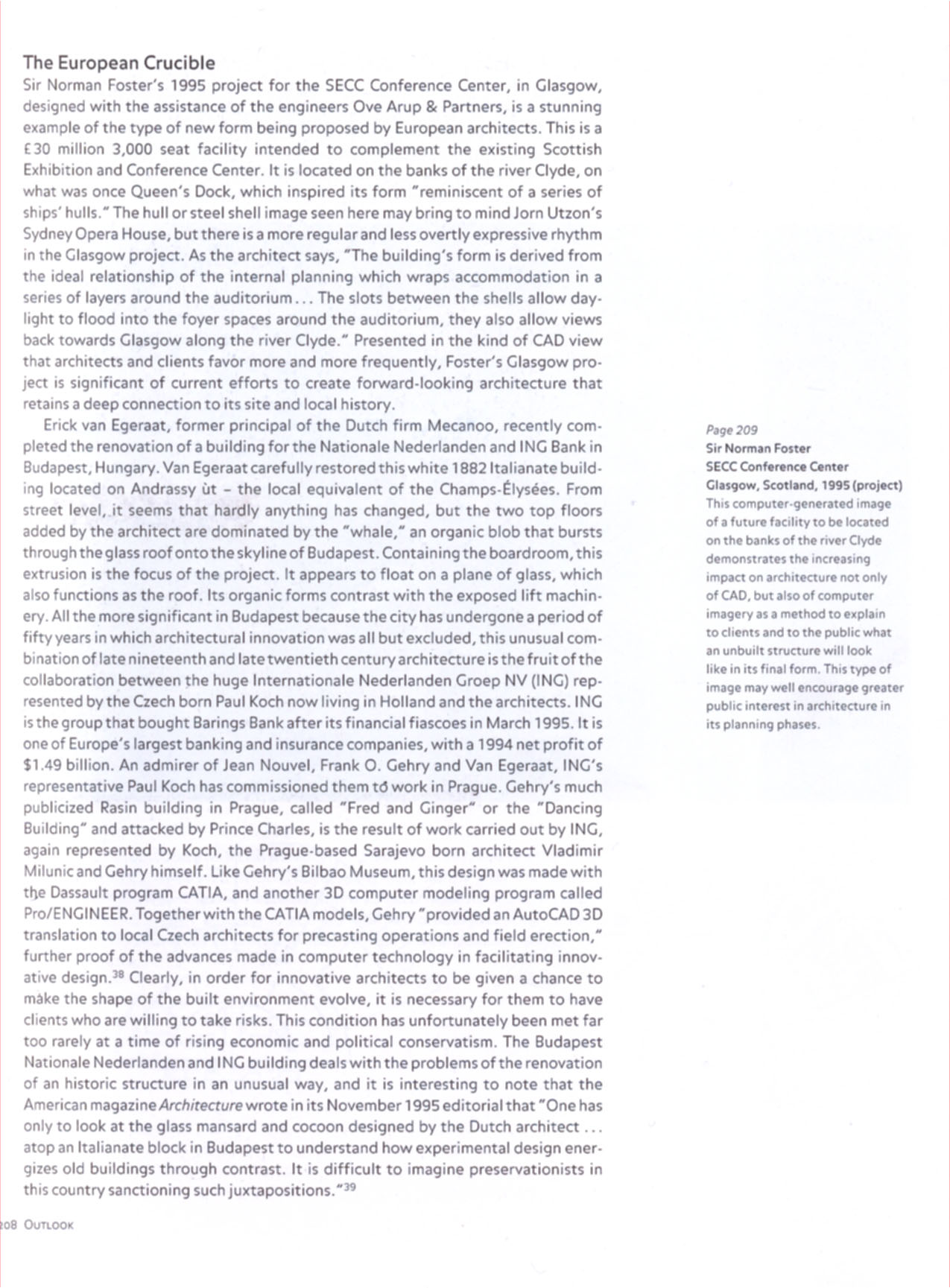New Forms Taschen 197

The European Crucible
Sir Norman Foster's 1995 projea for the SECC Conference Center, in Glasgow, designed with the assistance of the engineers Ove Arup & Partners, is a stunning example of the type of new form being proposed by European architects. This is a £30 million 3,000 seat facility intended to complement the existing Scottish Exhibition and Conference Center. It is located on the banks of the river Clyde, on what was once Queen's Dock, which inspired its form "reminiscent of a series of ships' hulls." The hull or Steel shell image seen here may bring to mind Jorn Utzon's Sydney Opera House, but there is a morę regular and less overtly expressive rhythm m the Glasgow project. As the architect says, 'The building's form is derived from the ideał relationship of the internal planning which wraps accommodation in a series of layers around the auditorium... The slots between the shells allow day-light to flood into the foyer spaces around the auditorium, they also allow views back towards Glasgow along the river Clyde.' Presented in the kind of CAD view that architeas and clients favor morę and morę frequently, Foster's Glasgow project is significant of current efforts to create forward-looking architeaure that retains a deep connection to its site and local history.
Pag* 209
Sir Norman Toster SECC Conference Center Clas90w. Scotland. 1995 (project)
This Computer gencratecJ image of a futurę facility to be located on the banks of the river Clyde demonstrates the inereasing impact on architeaure not only of CAD. but also of Computer imagery as a method to explain to clients and to the public what an unbuilt struaure will look like in its finał form. This type of image may well encourage greater public mterest in architeaure in its planning phases.
Erick van Egeraat, former principal of the Dutch firm Mecanoo, recently com-pleted the renovationof a buildingforthe Nationale Nederlanden and ING Bank in Budapest, Hungary. Van Egeraat carefully restored this white 1882 Italianate build-ing located on Andrassy ut - the local equivalent of the Champs-Elysees. From Street level, it seems that hardly anything has changed, but the two top floors added by the architect are dominated by the 'whale," an organie blob that bursts through the glass roof onto the skyline of Budapest. Containing the boardroom, this extrusion is the focus of the projea. It appears to float on a piane of glass, which also funaions as the roof. Its organie forms contrast with the exposed lift machin-ery. Ali the morę significant in Budapest because the city has undergone a period of fifty years in which architeaural innovation was all but excluded, this unusual com-bination of late nineteenth and late twentieth century architeaure is the f ruit of the collaboration between the huge Internationale Nederlanden Groep NV (ING) rep-resented by the Czech born Paul Koch now living in Holland and the architeas. ING is the group that bought Barings Bank after its f inancial f iaseoes in March 1995. It is one of Europe's largest banking and insurance companies, with a 1994 net profit of $1.49 billion. An admirer of Jean Nouvel, Frank O. Gehry and Van Egeraat, ING's representative Paul Koch has commissioned them td work in Prague. Gehry's much publicized Rasin building in Prague, called 'Fred and Ginger' or the "Dancing Building" and attacked by Prince Charles, is the result of work carried out by ING, again represented by Koch, the Prague-based Sarajevo born architea Vladimir Milunic and Gehry himself. Like Gehry's Bilbao Museum, this design was madę with the Dassault program CATIA, and another 3D Computer modeling program called Pro/ENGINEER. Together with the CATIA models, Gehry "provided an AutoCAD 3D translation to local Czech architeas for precasting operations and field ereaion," further proof of the advances madę in Computer technology in facilitating innov-ative design.38 Clearly, in order for innovative architeas to be given a chance to make the shape of the built environment evolve, it is necessary for them to have clients who are willing to take risks. This condition has unfortunately been met far too rarely at a time of rising economic and political conservatism. The Budapest Nationale Nederlanden and ING building deals with the problems of the renovation of an historie struaure in an unusual way, and it is interesting to notę that the American magazine Architeaure wrote in its November 1995 editorial that "One has only to look at the glass mansard and cocoon designed by the Dutch architea ... atop an Italianate błock in Budapest to understand how experimental design ener-gizes old buildings through contrast. It is difficult to imagine preservationists in this country sanaioning such juxtapositions."N
108 Outlook
Wyszukiwarka
Podobne podstrony:
New Forms Taschen 002 The decade sińce the mid-1980s has seen an unparalleled surge in architectural
New Forms Taschen 187 the work of Hermann Finsterlin. Deborah Dietsch brings these Johnson reference
68032 New Forms Taschen 007 The Magnificent Seven It was no accident that the seven architects chose
50770 New Forms Taschen 154 the lines between art and architecture, Richard Meier replies, "No.
New Forms Taschen 092 Mario Borta San Francisco Museum of Modem Art San Francisco, Califomia. 1990-9
25710 New Forms Taschen 162 Lebbeus Woods Havana Project Havana. Cuba. 1995 (project) Lebb
New Forms Taschen 170 Shapes for the Futurę Concentrating on Europę, the United States and Japan, th
więcej podobnych podstron